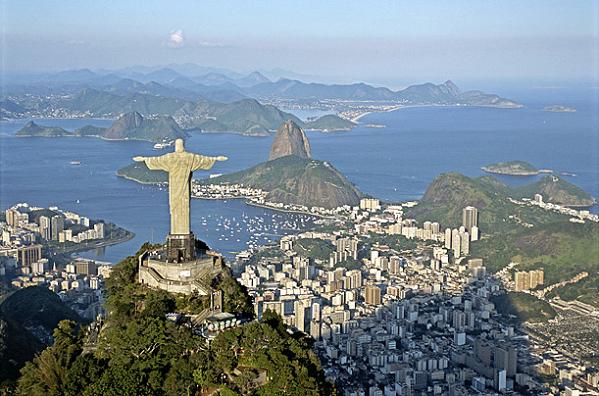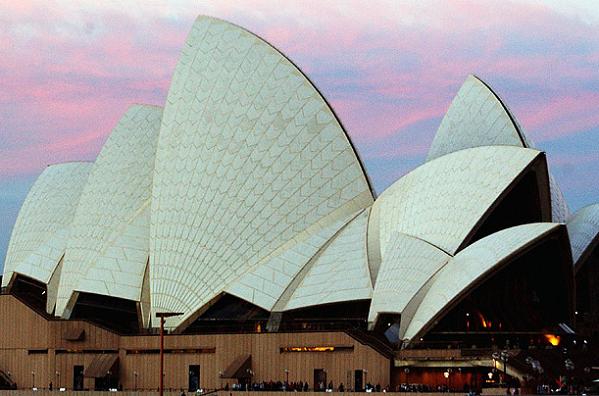amastroller
喜欢闲逛闲摄而已,无其它不良嗜好
The winners were voted for by Internet and phone globally, American Idol style. All the New 7 Wonders are equal and are presented as a group without any ranking.
The Pyramid at Chichén Itzá (before 800 A.D.) Yucatan Peninsula, Mexico
Chichén Itzá, the most famous Mayan temple city, served as the political and economic center of the Mayan civilization. Its various structures - the pyramid of Kukulkan, the Temple of Chac Mool, the Hall of the Thousand Pillars, and the Playing Field of the Prisoners – can still be seen today and are demonstrative of an extraordinary commitment to architectural space and composition. The pyramid itself was the last, and arguably the greatest, of all Mayan temples.
Christ Redeemer (1931) Rio de Janeiro, Brazil
This statue of Jesus stands some 38 meters tall, atop the Corcovado mountain overlooking Rio de Janeiro. Designed by Brazilian Heitor da Silva Costa and created by French sculptor Paul Landowski, it is one of the world’s best-known monuments. The statue took five years to construct and was inaugurated on October 12, 1931. It has become a symbol of the city and of the warmth of the Brazilian people, who receive visitors with open arms.
The Roman Colosseum (70 - 82 A.D.) Rome, Italy
This great amphitheater in the centre of Rome was built to give favors to successful legionnaires and to celebrate the glory of the Roman Empire. Its design concept still stands to this very day, and virtually every modern sports stadium some 2,000 years later still bears the irresistible imprint of the Colosseum's original design. Today, through films and history books, we are even more aware of the cruel fights and games that took place in this arena, all for the joy of the spectators.
The Great Wall of China (220 B.C and 1368 - 1644 A.D.) China
The Great Wall of China was built to link existing fortifications into a united defense system and better keep invading Mongol tribes out of China. It is the largest man-made monument ever to have been built and it is disputed that it is the only one visible from space. Many thousands of people must have given their lives to build this colossal construction.
Machu Picchu (1460-1470), Peru
In the 15th century, the Incan Emperor Pachacútec built a city in the clouds on the mountain known as Machu Picchu ("old mountain"). This extraordinary settlement lies halfway up the Andes Plateau, deep in the Amazon jungle and above the Urubamba River. It was probably abandoned by the Incas because of a smallpox outbreak and, after the Spanish defeated the Incan Empire, the city remained 'lost' for over three centuries. It was rediscovered by Hiram Bingham in 1911.
Petra (9 B.C. - 40 A.D.), Jordan
On the edge of the Arabian Desert, Petra was the glittering capital of the Nabataean empire of King Aretas IV (9 B.C. to 40 A.D.). Masters of water technology, the Nabataeans provided their city with great tunnel constructions and water chambers. A theater, modelled on Greek-Roman prototypes, had space for an audience of 4,000. Today, the Palace Tombs of Petra, with the 42-meter-high Hellenistic temple facade on the El-Deir Monastery, are impressive examples of Middle Eastern culture.
The Taj Mahal (1630 A.D.) Agra, India
This immense mausoleum was built on the orders of Shah Jahan, the fifth Muslim Mogul emperor, to honor the memory of his beloved late wife. Built out of white marble and standing in formally laid-out walled gardens, the Taj Mahal is regarded as the most perfect jewel of Muslim art in India. The emperor was consequently jailed and, it is said, could then only see the Taj Mahal out of his small cell window.
The following sites always will remain Official New7Wonders Finalists, which were nominated from hundreds of sites around the world
The Acropolis of Athens (450 - 330 B.C.) Athens, Greece

Built atop what is known as the “Sacred Rock” of Athens, the Acropolis was to radiate power and protection for its citizens. The temples of the Acropolis have become the some of most famous architectural landmarks of ancient and modern history. Today, the Parthenon in particular is an international symbol of Greek civilization. A graphic illustration of the temple also appears in the UNESCO logo, representing culture and education.
Alhambra (12th century) Granada, Spain

Mohammed I, the first king of the Nasriden – a Moorish dynasty in Granada - converted a 9th-century castle into his private royal residence, and it is this which we now know as the Alhambra. The structure, which covers an area of 13 hectares, is renowned for its stunning frescoes and interior detail. The building is one of the finest examples of Moorish architecture in the world and is among Europe’s most-visited tourist attractions.
Angkor (12th century) Cambodia

Angkor is the most important monument of the south-east Asian Khmer Empire and the world’s largest sacred temple. Built during the reign of King Suryavaman, at the beginning of the 12th century, Angkor is noted for its intricate ornamentation and striking beauty. With its water moats, concentric walls and magnificent temple mountain in the center, Angkor Wat symbolizes the Hindu cosmos, with its oceans at the periphery and the Meru mountain at the center of its universe.
Statues of Easter Island (10th - 16th Century) Easter Island, Chile

Discovered on Easter Sunday, 1722 by Dutch explorer Jakob Roggeveen, this collection of 25 meter-high stone sculptures still puzzles historians and archaeologists as to its origins. It is believed that a society of Polynesian origin settled here in the 4th century and established a unique tradition of monumental sculpture. Between the 10th and 16th centuries, they erected the enormous stone figures, known as the Moai, which have long fascinated the entire world and endowed this island with a mythical atmosphere.
The Eiffel Tower (1887 - 89) Paris, France

The creation of Gustave Eiffel, this magnificent steel tower has come to serve as a symbol of Paris, as well as of France itself. The structure is not only a landmark that is recognized all over the world, but is perhaps the most popular architectural achievement in the Western world. It was the tallest man-made structure in the world until the Empire State Building was constructed. The tower is visited by six million people every year.
The Hagia Sophia (532 - 537 A.D.) Istanbul, Turkey

The Hagia Sophia was erected during the reign of Emperor Justinian (532 - 537 A.D.), when the Byzantine Empire was at the height of its power and influence. The massive dome, which is the prominent architectural feature, has since often been used as a model for the design of Islamic mosques. Indeed, after the fall of Byzantium, the Hagia Sophia was converted into an Ottoman mosque. Today, the monument is a museum serving both Christians and Muslims.
Kiyomizu Temple (749 - 1855) Kyoto, Japan

Laid out in 794 A.D., the palaces and temples of Kyoto were the residences of Japan's emperors and shoguns for more than 1,000 years. The Japanese Emperor is enthroned at the Imperial Palace of Gosho. Among other significant works are the Higashi Nonganji and Nishi Hoganji temple complexes, the Kinkakuji Temple with its 'Golden Pavilion' and the Kiyomizu Temple, the temple of “clear waters.” The Kyoto sites have been destroyed and rebuilt many times throughout history and are today among Asia's greatest cultural heritage sites.
The Kremlin and Red Square (1156 - 1850) Moscow, Russia

Built as a residence for Ivan I, the Kremlin was the official residence of the Czars until the 1917 Russian Revolution. Today, it still houses the President’s office. In front of the Kremlin is Red Square – an impressive and exuberant plaza which, for many people, is associated with the infamous May Day demonstrations. Rising from the square is St Basil's Cathedral, built in the 1550s to commemorate Ivan the Terrible's capture of the Mongol stronghold of Kazan.
Neuschwanstein Castle (1869 -1884) Schwangau, Germany

Neuschwanstein Castle was built in a time when castles and fortresses were no longer strategically necessary. Instead, it was born of pure fantasy – a beautiful, romantic composition of towers and walls in the perfect setting of mountains and lakes. The combination of various architectural styles and intrinsic craftwork has inspired generations of adults and children alike.
The Pyramids of Giza (2600 - 2500 B.C), Egypt

The Pyramids of Giza, the oldest and only Ancient Wonder still standing, are testimony to perfection in art and design, never subsequently achieved. They were built by planners and engineers purely to serve their earthy rulers - who were also their gods. Philosophy did not exist at this time, and creation was not subject to any questioning. The pyramids are the purest of constructions, built for eternity. After careful consideration, the New7Wonders Foundation designated the Pyramids of Giza - the only remaining of the 7 Ancient Wonders of the World - as an Honorary New7Wonders Candidate. Therefore, people could not vote for the Pyramids of Giza as part of the New7Wonders campaign. This decision has also taken into account the views of the Supreme Council of Antiquities of Egypt and the Egyptian Ministry of Culture. The Pyramids are a shared world culture and heritage site and deserve their special status as the only Honorary Candidate of the New7Wonders of the World campaign. The 7 New Wonders of the World where chosen by the people across the globe from the remaining 20 New7Wonders candidates.
The Statue of Liberty (1886) New York City, U.S.A.

The Statue of Liberty was a gift of the French government to the United States to honor the ideals of freedom and independence. It was a very early gesture of national generosity. This huge statue became a symbol of hope and freedom for many hundreds of millions of people who immigrated to the United States during the 20th century to find a new life of peace and prosperity. It is also the one New7Wonders candidate that most closely resembles one of the Ancient 7 Wonders - The Colossus of Rhodes.
Stonehenge (3000 B.C. - 1600 B.C.) Amesbury, United Kingdom

Construction of Stonehenge took place between ca. 3000 and 1600 B.C. With each stone weighing around 50 tons, it is regarded as a truly amazing feat of engineering. Although it is not clear who built the monument, nor for what purpose, it has been speculated that it was either a temple dedicated to the worship of ancient earth deities, an astronomical observatory or a sacred burial site.
Sydney Opera House (1954 - 73) Sydney, Australia

When the Sydney Opera House was finished in 1973, this landmark building - in the true sense of the expression, - put the whole continent of Australia on the world map. This building does not imitate or reflect what we generally imagine an opera house might look like, indeed, it is a completely abstract interpretation. The ability to create abstract art only developed after the invention of photography in the late 19th century, when painters first began to experiment with an abstract, cubist interpretation of reality.
Timbuktu (12th century) Mali

In the 12th century, Timbuktu was at the crossroads of the four most important caravan paths supplying the Arab world, which then spanned from the Middle East all the way to Spain. The accumulation of wealth made it one of the wealthiest places on earth at the time. This allowed one of the first universities in the history of humankind to be established– the celebrated Islamic university called the Koranic Sankore, where 20,000 students studied law, medicine, rhetoric, etc. Today, it remains with us as a powerful myth and, in this way, resembles another Ancient Wonder, the Hanging Gardens of Babylon.




